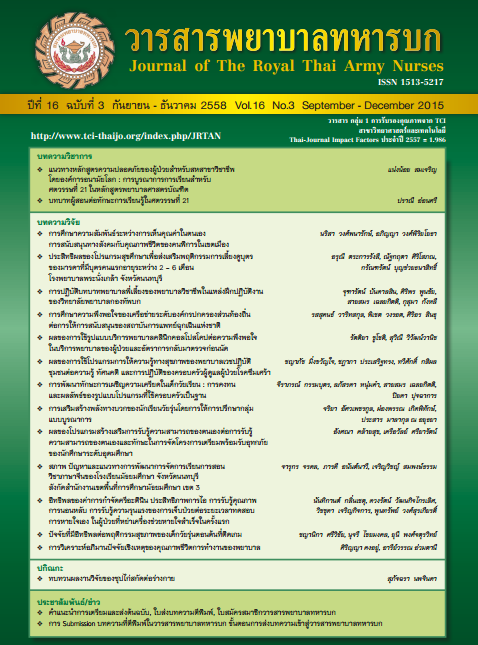การปฏิบัติบทบาทพยาบาลพี่เลี้ยงของพยาบาลวิชาชีพ ในแหล่งฝึกปฏิบัติงานของวิทยาลัยพยาบาลกองทัพบก; Practices in Preceptor’s Role of Professional Nurses in the Training Places of The Royal Thai Army Nursing College
Keywords:
การปฏิบัติบทบาทพยาบาลพี่เลี้ยง, พยาบาลพี่เลี้ยงนักเรียนพยาบาล, the practices of nurse preceptors’ role, nurse preceptors of nursing studentsAbstract
การวิจัยครั้งนี้เป็นการวิจัยเชิงพรรณนา เพื่อศึกษาการปฏิบัติบทบาทพยาบาลพี่เลี้ยงของพยาบาลวิชาชีพในแหล่งฝึกปฏิบัติงานของวิทยาลัยพยาบาลกองทัพบก ปีการศึกษา 2556 กลุ่มตัวอย่างเป็นพยาบาลวิชาชีพในแหล่งฝึกประสบการณ์ของนักเรียนพยาบาลกองทัพบก จำนวน 234 คน เก็บข้อมูลโดยการตอบแบบสอบถามที่ประกอบด้วยข้อมูลทั่วไป การปฏิบัติบทบาทพยาบาลพี่เลี้ยง ความพึงพอใจต่อการปฏิบัติหน้าที่พยาบาลพี่เลี้ยง ปัญหาข้อขัดข้องและความต้องการพัฒนาของพยาบาลพี่เลี้ยง วิเคราะห์ข้อมูลโดยใช้สถิติร้อยละ คะแนนเฉลี่ย ส่วนเบี่ยงเบนมาตรฐาน และสถิติวิเคราะห์ความแปรปรวนทางเดียว 2)ผลการศึกษาพบว่า พยาบาลวิชาชีพที่ทำหน้าที่พยาบาลพี่เลี้ยงนักเรียนพยาบาลมีการปฏิบัติบทบาทพยาบาลพี่เลี้ยง โดยรวมอยู่ในระดับมาก ( = 4.33, S.D.
= 0.62) ส่วนรายด้านที่มีคะแนนสูงสุด คือ ด้านการเป็นแบบอย่างมีคะแนนเฉลี่ยอยู่ในระดับมากที่สุด (
= 4.56, SD = 0.57) ด้านที่มีคะแนนต่ำสุด คือ ด้านการประเมินผลมีคะแนนเฉลี่ยอยู่ในระดับมาก (
= 4.23, SD = 0.61) เมื่อเปรียบเทียบการปฏิบัติบทบาทพยาบาลพี่เลี้ยงของพยาบาลวิชาชีพที่มีประสบการณ์การทำงาน และประสบการณ์br>การเป็นพยาบาลพี่เลี้ยง และสถานที่ปฏิบัติงานที่แตกต่างกัน พบว่าการปฏิบัติบทบาทพยาบาลพี่เลี้ยงโดยรวมไม่มีความแตกต่างกัน หากพิจารณาเป็นรายด้านด้วยวิธี LSD พบว่า 1) การปฏิบัติบทบาทพยาบาลพี่เลี้ยงด้านการให้คำแนะนำปรึกษาและด้านการเป็นแบบอย่างของกลุ่มที่มีประสบการณ์การทำงานมากกว่า 10 ปี มีคะแนนเฉลี่ยสูงกว่ากลุ่มที่มีประสบการณ์ทำงาน 2 - 4 ปี อย่างมีนัยสำคัญทางสถิติ (p < .05 และ p < .05 ตามลำดับ) 2) การปฏิบัติบทบาทพยาบาลพี่เลี้ยงด้านการให้คำแนะนำปรึกษาของกลุ่มที่มีประสบการณ์การเป็นพยาบาลพี่เลี้ยงมากกว่า 7 ปี มีคะแนนเฉลี่ยสูงกว่ากลุ่มที่มีประสบการณ์เป็นพยาบาลพี่เลี้ยง 1 - 2 ปี อย่างมีนัยสำคัญทางสถิติ (p < .05) และ 3) การปฏิบัติบทบาทพยาบาลพี่เลี้ยงด้านการสนับสนุนส่งเสริม และด้านการเป็นแบบอย่างของกลุ่มที่ปฏิบัติงานในสถานพยาบาล/โรงพยาบาลระดับปฐมภูมิมีคะแนนเฉลี่ยสูงกว่าโรงพยาบาลระดับตติยภูมิ อย่างมีนัยสำคัญทางสถิติ (p < .05 และ p < .05 ตามลำดับ) ความพึงพอใจของพยาบาลวิชาชีพต่อการปฏิบัติบทบาทพยาบาลพี่เลี้ยงโดยรวมอยู่ในระดับมากที่สุด (
= 4.51, SD = 0.58) ส่วนปัญหาในการปฏิบัติบทบาทพยาบาลพี่เลี้ยง ได้แก่ พยาบาลพี่เลี้ยงมีภาระงานประจำมากทำให้ทำหน้าที่พยาบาลพี่เลี้ยงได้ไม่สมบูรณ์ บางหอผู้ป่วยของโรงพยาบาลระดับตติยภูมิมีพยาบาลวิชาชีพที่มีประสบการณ์ทำงานไม่ถึง 3 ปี และยังไม่ผ่านการอบรม พยาบาลพี่เลี้ยงต้องปฏิบัติหน้าที่พยาบาลพี่เลี้ยงนักเรียนพยาบาลเนื่องจากขาดแคลนกำลังคน ทำให้พยาบาลพี่เลี้ยงขาดความมั่นใจในการสอน สำหรับความต้องการพัฒนา พบว่า พยาบาลพี่เลี้ยงต้องการพัฒนาด้านเทคนิคการสอนทางคลินิก การวิเคราะห์ปัญหาจริยธรรม และกฎหมายที่เกี่ยวข้อง และการประเมินผลการปฏิบัติงานที่มีความถูกต้องเป็นมาตรฐานเดียวกัน
The purpose of this study 1) to examine the practices of nurse preceptors’ role for nursing students during Academic year 2013 2) to measure nurse preceptors’ satisfaction 3) to study problems and obstacles on nurse preceptors’ role. Data were collected from 234 nurse preceptors who worked in Bangkok and urban primary health care unit/hospitals, secondary hospitals and tertiary hospital which were the clinical sites of The Royal Thai Army Nursing College. The questionnaire had four parts including personal data, the practices of nurse preceptor’s role, the satisfaction of the practices of nurse preceptor’s role and the nurse preceptors’ problems. Data were analysed by descriptive statistics and analysis of variances (ANOVA). The findings showed 1) the mean score of the practices of nurse preceptors’ role are at high level ( = 4.33 SD = 0.62). Considering in each role showed that nurse preceptors’ highest on the role model (
= 4.56 SD = 0.57) and the lowest on the evaluation of performance (
= 4.23, SD = 0.61). Moreover, the practices of nurse preceptors’ role were compared among nurse preceptor who had difference in work experience, preceptorship experience and work places. The finding indicated that there weren’t statistical significant in the difference of the total practices of nurse preceptors’ role. However, considering on each of practices of nurse preceptors’ role were reported as follow : 1) the nurse preceptors who had worked experience more than 10 years had higher mean score of counselling role and role-model than the others who had worked experience for 2-4 years (p < .05) 2) the nurse preceptors who had preceptorship experience more than 7 years had higher mean score of counselling role than the others had preceptorship experience for 1-2 years (p < .05) 3) the nurse preceptors who worked in the primary health care unit/hospital had higher mean score of supportive-promoted role and role-model than the others in the tertiary hospital (p < .05). For the satisfaction of practices of nurse preceptors’ role had the mean score at high level (
= 4.51, SD = 0.581). Furthermore, the problems of the practices of nurse preceptors’ role were over workload in routine task. In some unit had the professional nurses who had worked experience below 3 year and weren’t trained in the preceptor’s program. Thus. They lacked confidence to teach and supervise nursing students effectively. Finally, the developed needs of nurse preceptors were teaching technique, nursing ethics and laws and evaluation methods.
Downloads
How to Cite
Issue
Section
License
บทความหรือข้อคิดเห็นใดใดที่ปรากฏในวารสารพยาบาลทหารบกเป็นวรรณกรรมของผู้เขียน ซึ่งบรรณาธิการหรือสมาคมพยาบาลทหารบก ไม่จำเป็นต้องเห็นด้วย
บทความที่ได้รับการตีพิมพ์เป็นลิขสิทธิ์ของวารสารพยาบาลทหารบก
The ideas and opinions expressed in the Journal of The Royal Thai Army Nurses are those of the authors and not necessarily those
of the editor or Royal Thai Army Nurses Association.





